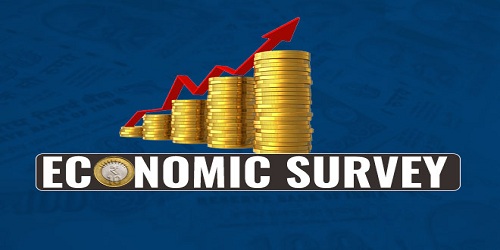On January 29, 2018, Union Finance Minister, Arun Jaitley tabled the Economic Survey 2017-18 in Parliament. Economic Survey is a flagship annual document of the Ministry of Finance, Government of India.
- Economic Survey 2017–18 reviews the developments in the Indian economy over the previous 12 months and provides a summary of the performance on major development programmes and highlights the policy initiatives of the government and the prospects for the upcoming year.
- Economic Survey2017–18, has been prepared by Chief Economic Adviser, Arvind Subramanian.
- This year, the colour of the Economic Survey document is Pink. It has been chosen to lay special emphasis on Gender and Son meta-preference prevailing in Indian society.
Highlights of Economic Survey 2017-18
GDP Growth:
As per Economic Survey 2017-18, Indian economy is expected to grow between 7 per cent and 7.5 per cent in the next fiscal year i.e. April 1, 2018 – March 31, 2019.
- The forecasted growth will primarily come on account of series of major reforms ( including roll out of Goods and Services Tax, Public sector bank recapitalisation plan, Indian Bankruptcy Code and relaxations in Foreign Direct Investment limits) undertaken over the past one year. On attaining 7-7.5% growth, India will regain its status of fastest growing major economy.
- However, increase in crude oil prices in the international market and protectionist tendencies adopted by some countries have been identified as key risks to growth in 2018-19.
- GDP growth for the current fiscal year, ending March 31, 2018 is expected to be 6.75 per cent.
- Sectoral Growth: Services growth for FY 2017-18 is expected to be 8.3 percent while industry and agriculture are expected to grow at 4.4 percent and 2.1 percent respectively.
Inflation:
Economic Survey has revealed that average consumer price inflation based headline inflation declined to a six-year low of 3.3 per cent in 2017-18.
- Owing to this, Indian economy is now moving from a phase of high and variable inflation to a more stable price regime.
- During 2017-18, Inflation in 17 Indian states was below 4 per cent.
Direct Tax Collection:
During April-November 2017 period, direct tax collections of the Centre grew by 13.7 per cent, which is in line with previous year.
- There has been an addition of about 18 lakh individual income tax filers since November 2016.
Indirect Tax Collection (under GST era):
During April-November 2017 period, indirect tax collections of the Centre grew by 18.3 per cent, which is in line with previous year.
- During April-November 2017, States’ share in taxes grew by 25.2 per cent.
- However, clearer outcome in indirect taxes during this year will depend on the final settlement of GST accounts between the Centre and the States.
- There has been a fifty percent increase in the number of indirect taxpayers.
- As on December 2017, number of unique GST registrants stood at 9.8 million, which is slightly more than the total Indirect Tax registrants under old tax system.
International & Inter-State Trade:
Top 1% Indian exporters account for only 38 percent of exports. This proportion is much higher in other countries – 72, 68, 67, and 55 % in Brazil, Germany, Mexico, & USA, respectively
- For the first time, data on the international exports of states has been presented in the Economic Survey.
- Five states – Maharashtra, Gujarat, Karnataka, Tamil Nadu and Telangana account for 70 per cent of India’s exports.
- India’s internal trade in Goods & Services is about 60 per cent of GDP.
- Rebate of State Levies (ROSL) has boosted exports of readymade garments (man-made fibers) by about 16 per cent.
Gender Bias:
Economic Survey 2017-18 outlined that Indian society exhibits a strong desire for a male child.
- This mindset is reflected from the fact that most parents continued to have children until they get number of sons.
- Details about various scenarios leading to skewed sex ratios have also been given in the survey.
Social Infrastructure, Employment and Human Development:
Bridging the gender gaps in education, skill development, employment and earnings and reducing social inequalities have been outlined as underlying goals of the development strategy.
- During 2012-13 to 2014-15, expenditure on social services by the Centre and States as a proportion of GDP had remained in the range of 6 per cent while in 2017-18, it stood at 6.6 per cent.
Impact of Climate Change:
Economic Survey has warned that Climate change could reduce annual agricultural incomes in the range of 15 percent to 18 percent on average, and up to 20 percent to 25 percent for unirrigated areas.
- This estimate holds lot of significance as agriculture growth and farm revenues have stagnated in the past four years due to repeated monsoon failures.
- To counter this challenge, the survey has recommended bringing science and technology to farmers, replacing untargeted subsidies by direct income support, and extending irrigation through efficient drip and sprinkler technologies.
Other important information:
Insurance penetration (the ratio of premium underwritten in a given year to the gross domestic product) in India increased to 3.49% in 2016-17 from 2.71% in 2001.
- About 66 per cent of pending tax dispute cases accounted for only 1.8 per cent of value at stake.
- The survey mentions, collections of direct taxes by Indian states and other local governments, is significantly lower as compared to their counterparts in other federal countries.
- Agriculture, education, and employment will be areas of focus in the medium term.
- The survey asserted that growth in investments rather than growth in savings leads to economic growth.




